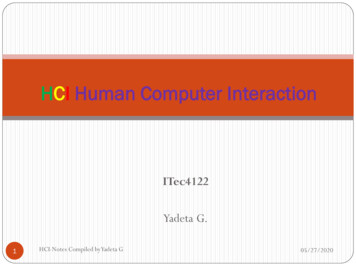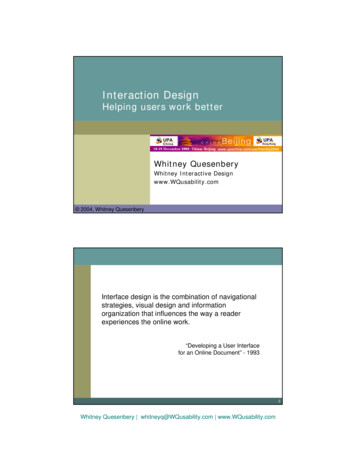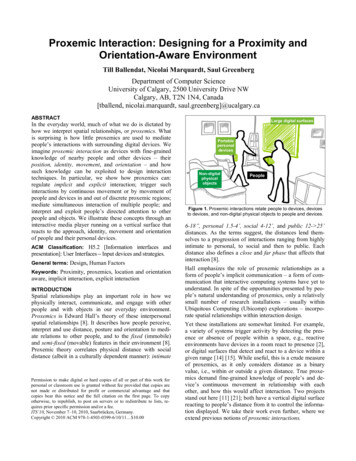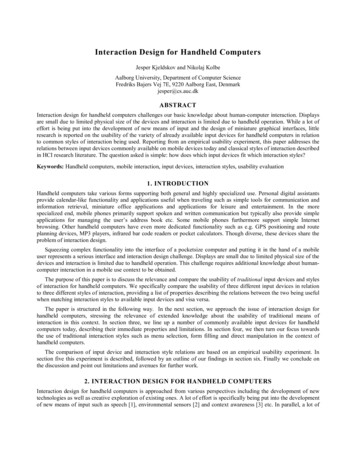
Transcription
HCI Human Computer InteractionITec4122Yadeta G.1HCI-Notes Compiled by Yadeta G05/27/2020
OutlinesIntroduction2. Human in HCI3. Computer in HCI4. Interaction5. Interaction Design & HCI Software process6. Design Rules and Implementation Support7. Evaluation Techniques and Universal Design8. User SupportEvaluation Methods:60% Continuous Assessments and 40% final Exam1.2HCI-Notes Compiled by Yadeta G05/27/2020
What is this course about? How to make a good (usable) user interface for aninteractive application Why are usable user interfaces important? Nearly all applications have a user interface Bad interfaces are frustrating for the user andwill influence the productivity Competitors may have better systems Good user interface are hardly noticed, bad onesare! It is easier to make a bad interface than a good one.3HCI-Notes Compiled by Yadeta G05/27/2020
IntroductionWhat is Human Computer Interaction (HCI)? As defined by theSpecial Interest Group on Human-Computer Interaction (SIGCHI)of the Association for Computing Machinery (ACM)“Human Computer Interaction is a discipline concerned with thedesign, evaluation and implementation of interactive computingsystems for human use and with the study of the majorphenomena surrounding them.”(HCI) is a cross-disciplinary area (e.g., engineering,psychology, ergonomics, and design) that deals with thetheory, design, implementation, and evaluation of the ways thathumans use and interact with computing devices.4HCI-Notes Compiled by Yadeta G05/27/2020
Introduction cont’d HCI is the study of how people interact with computers andto what extent computers are or are not developed forsuccessful interaction with human beingsHCI concerns: process: design, evaluation and implementation on: interactive computing systems for human use 5plus: the study of major phenomena surrounding them(ergonometric).HCI-Notes Compiled by Yadeta G05/27/2020
Humans, Computers and Interaction The Humans good at: Sensing low level stimuli, patternrecognition, inductive reasoning, multiple strategies,adapting “Hard and fuzzy things”. The Computers good at: Counting and measuring, accuratestorage and recall, rapid and consistent responses, dataprocessing/calculation, repetitive actions, performance overtime, “Simple and sharply defined things”. The Interaction focused on the list of skills is somewhatcomplementary. Let humans do what humans do best andcomputers do what computers do best.6HCI-Notes Compiled by Yadeta G05/27/2020
A major shift 50s - Interface at the hardware level for engineers - switch panels60-70s - interface at the programming level - COBOL,FORTRAN70-90s - Interface at the terminal level - command languages80s - Interface at the interaction dialogue level - GUIs,multimedia90s - Interface at the work setting - networked systems,groupwareThe current technologies were the product of previous HCIconcept.7HCI-Notes Compiled by Yadeta G05/27/2020
From HCI to Interaction Design Human-computer interaction (HCI) is: “concerned with thedesign, evaluation and implementation of interactive computingsystems for human use and with the study of major phenomenasurrounding them” Interaction design (ID) is: “the design of spaces for humancommunication and interaction” One distinction: more application areas, moretechnologiesand more issues to consider when designing ‘interfaces’8HCI-Notes Compiled by Yadeta G05/27/2020
Relationship between ID, HCI and otherfieldsAcademicdisciplines(e.g. computerscience,psychology)Design practices(e.g. graphic design)InteractionDesignInterdisciplinary fields(e.g HCI, CSCW)9HCI-Notes Compiled by Yadeta G05/27/2020
Goals of HCITo develop or improve the Safety Utility Effectiveness Efficiency Usability Appeal (application). . . of systems that include computers10HCI-Notes Compiled by Yadeta G05/27/2020
The goals of HCITo achieve usability, the design of the user interface to anyinteractive product, needs to take into account and betailored around a number of factors, including: Cognitive, perceptual, and motor capabilities and constraintsof people in general Special and unique characteristics of the intended userpopulation in particular Unique characteristics of the users’ physical and social workenvironment Unique characteristics and requirements of the users’ tasks,which are being supported by the software Unique capabilities and constraints of the chosen softwareand/or hardware and platform for the product11HCI-Notes Compiled by Yadeta G05/27/2020
Safety Safety of Users—think of Air traffic control Hospital intensive care Safety of Data—think of Protection of files from tampering Privacy and security12HCI-Notes Compiled by Yadeta G05/27/2020
Relationship of HCI wither other Disciplines13HCI-Notes Compiled by Yadeta G05/27/2020
Fields that HCI builds on Computer Science Implementation of software Engineering Faster, cheaper equipment Ergonomics Design for human factors Graphic design Visual communication Technical writing Textual communication14HCI-Notes Compiled by Yadeta G05/27/2020
Fields that HCI builds on Linguistics, artificial intelligence Speech recognition, natural language processing Cognitive psychology Perception, memory, mental models Sociology How people interact in groups Anthropology Study of people in their work settings15HCI-Notes Compiled by Yadeta G05/27/2020
Topics in HCI16HCI-Notes Compiled by Yadeta G05/27/2020
Topics in HCIComputer systems exist within a larger social, organizational andwork milieu (U1).Within this context there are applications for which we wish toemploy computer systems (U2).But the process of putting computers to work means that thehuman, technical, and work aspects of the application situationmust be brought into fit with each other through human learning,system tailorability, or other strategies (U3).17HCI-Notes Compiled by Yadeta G05/27/2020
Topics in HCIIn addition to the use and social context of computers, on thehuman side we must also take into account:the human information processing (H1)communication (H2)and physical (H3) characteristics of users18HCI-Notes Compiled by Yadeta G05/27/2020
Topics in HCIOn the computer side, a variety of technologies have been developed forsupporting interaction with humans:Input and output devices connect the human and the machine (C1).These are used in a number of techniques for organizing a dialogue (C2).These techniques are used in turn to implement larger design elements, suchas the metaphor of the interface (C3).Getting deeper into the machine substrata supporting the dialogue, thedialogue may make extensive use of computer graphics techniques (C4).19HCI-Notes Compiled by Yadeta G05/27/2020
Topics in HCIComplex dialogues lead into considerations of the systems architecturenecessary to support such features as interconnect-able applicationprograms, windowing, real-time response, network communications, multiuser and cooperative interfaces, and multi-tasking of dialogue objects (C5).Finally, there is the process of development which incorporates design (D1)for human-computer dialogues, techniques and tools (D2) for implementingthem (D2), techniques for evaluating (D3) them, and a number of classicdesigns for study (D4).20HCI-Notes Compiled by Yadeta G05/27/2020
Human in HCIHumans are limited in their capacity to processinformation. But it has important implications for design.Information is received and responses given via a numberof input and output channels.These channels are: Visual channel Auditory channel Haptic channel Movement21HCI-Notes Compiled by Yadeta G05/27/2020
Human Input-Output channels A person’s interaction with the outside world occursthrough information being received and sent (input andoutput). In interaction, the user receive the informationdisplayed by the computer and sent information formachine. In other speaking output info for human is input formachine and input info for human is output forcomputer.22HCI-Notes Compiled by Yadeta G05/27/2020
Information is stored in memoryThe human memories are categorized as:o Sensory memoryo Short-term memoryo Long-term memory It sentiments about feeling. Users share common capabilities but are individuals withdifferences, which should not be ignored. We should have to appreciate with the diversity23HCI-Notes Compiled by Yadeta G05/27/2020
Sensory memory The sensory memories act as buffers for stimuli receivedthrough the senses. A sensory memory exists for each sensory channel: iconicmemory for visual stimuli, echoic memory for aural stimuliand haptic memory for touch. These memories are constantly overwritten by newinformation coming in on these channels.24HCI-Notes Compiled by Yadeta G05/27/2020
Short-term memory Short-term memory acts as a ‘scratch-pad’ for temporaryrecall of information. It is used to store information which is only required briefly. For example, calculate the multiplication 35 6 in yourhead. Short-term memory also has a limited capacity25HCI-Notes Compiled by Yadeta G05/27/2020
Long-term memory If short-term memory is our working memory or ‘scratch 26pad’, long-term memory is our main resource.Here we store real information, experimental knowledge,and procedural rules of behavior in fact,It differs from short-term memory in a number of significantways.First, it has a huge, if not unlimited, capacity.Secondly, it has a relatively slow access time ofapproximately a tenth of a second.Thirdly, forgetting occurs more slowly in long-termmemory, if at all.HCI-Notes Compiled by Yadeta G05/27/2020
Human in description HCI We start with the human, the central character in any 27discussion of interactivesystems.The human (user), is after all, the one whom computersystems are designed to assist.The requirements of the user should therefore be our firstpriority.In this chapter we will look at areas of human psychologycoming under the general exceptional of cognitivepsychology.One way to structure this discussion is to think of the user ina way that highlights these aspects. In other words, to think ofa simplified model of what is actually going on?HCI-Notes Compiled by Yadeta G05/27/2020
. Cont’d There are five major senses: sight, hearing, touch, tasteand smell. Of these, the first three are the most important to HCI.The human input/output channels are: Visual channel for Seeing Auditory for Hearing Haptic or sense for touching Movement, and the like28HCI-Notes Compiled by Yadeta G05/27/2020
Information Processing in HumanInformation is processed and applied in human bay:o Reasoningo Problem Solvingo Skill acquisitiono Error understandingEmotion can influences human capabilities29HCI-Notes Compiled by Yadeta G05/27/2020
THINKING: REASONING AND PROBLEM SOLVING We have considered how information finds its way into andout of the human system and how it is stored. Finally, we come to look at how it is processed andmanipulated. This is perhaps the area which is most complex and whichseparates humans from other information-processingsystems, both artificial and natural. Human thought is conscious/ mindful and self-aware: whilewe may not always be able to identify the processes we use,we can identify the products of these processes, our thoughts.30HCI-Notes Compiled by Yadeta G05/27/2020
Thinking cont’d In addition, we are able to think about things of which wehave no experience, and solve problems which we have neverseen before. Thinking can require different amounts of knowledge. Some thinking activities are directed and the knowledgerequired is constrained. Others require vast amounts of knowledge from differentareas.For instance: the knowledge we used for solving problem bycalculation and understanding the newspaper headlines.31HCI-Notes Compiled by Yadeta G05/27/2020
Reasoning Reasoning is the process by which we use the knowledge wehave to draw conclusions or infer something new about thedomain of interest. There are a number of different types of reasoning:deductive, inductive and abductive. We use each of these types of reasoning in everyday life, butthey differ in significant ways.32HCI-Notes Compiled by Yadeta G05/27/2020
Deductive reasoning Deductive reasoning derives the logically necessary conclusion fromthe given premises. For example, it goes from general to specific idea.If it is Friday then she will go to workIt is FridayTherefore she will go to work. It is important to note that this is the logical conclusion from thepremises; it does not necessarily have to correspond to our notion oftruth. So, for example,If it is raining then the ground is dryIt is rainingTherefore the ground is dry.33HCI-Notes Compiled by Yadeta G05/27/2020
Inductive reasoning Induction is generalizing from cases we have seen to concludeinformation about cases we have not seen. For example, if every elephant we have ever seen has a trunk,we infer that all elephants have trunks. The best that we can do is gather evidence to support ourinductive inference.34HCI-Notes Compiled by Yadeta G05/27/2020
Abductive reasoning Thetype of reasoning whereby one seeks toexplain relevant evidence by beginning with some commonlywell known facts that are already accepted andthen working towards an explanation. The third type of reasoning is abduction. Abduction reasonsfrom a fact to the action or state that caused it. This is the method we use to derive explanations for theevents we observe. For example: suppose we know that Sami always drives toofast when he has been drinking. If we see Sami driving toofast we may infer that he has been drinking.35HCI-Notes Compiled by Yadeta G05/27/2020
Problem solving Reasoning is a means of concluding new information from 36what is already known,Problem solving is the process of finding a solution to anunfamiliar task, using the knowledge we have.Human problem solving is characterized by the ability toadapt the information we have to deal with new situations.However, often solutions seem to be original and creative.There are a number of different views of how people solveproblems.HCI-Notes Compiled by Yadeta G05/27/2020
Three views of how human to solve problems Gestalt view: the earliest, dating back to the first half of the 37twentieth century is that problem solving involves both reuseof knowledge and understanding.Problem Space Theory: this takes the view that mind islimited information processor.It generating both problem states (initial state and goal state)Analogy in Problem Solving: this is use the analogy whilesolving the problemImplemented by mapping knowledge related to the similardomain (analog mapping) old knowledge is used to solve newproblemHCI-Notes Compiled by Yadeta G05/27/2020
Skill acquisition The entire problem solving that we have considered so far hasconcentrated on handling unfamiliar problems. However, for much of the time, the problems that we face arenot completely new. Instead, we gradually acquire skill in a particular domainarea. We can gain insight into how skilled behavior works, and howskills are acquired, by considering the difference betweennovice and expert behavior in given domains.Discuss: If we have no prior knowledge how we solveproblem?38HCI-Notes Compiled by Yadeta G05/27/2020
Error and mental model Human capability for interpreting and manipulating 39information is quite impressive.However, we do make mistakes. Some are trivial, resulting inno more than temporary inconvenience or frustration.Others may be more serious, requiring substantial effort tocorrect.Occasionally an error may have catastrophic effects, as we seewhen ‘human error’ results in a plane crash or nuclear plantescape.In order to answer the latter part of the question we must firstlook at what is going on when we make an error.HCI-Notes Compiled by Yadeta G05/27/2020
Mental model People build their own theories to understand the causalbehavior of systems. This is known as mental model. Mental model characteristics Emotion Individual difference Psychology Designing of Interactive systems40HCI-Notes Compiled by Yadeta G05/27/2020
Computer in HCI A computer system contains various elements, each of whichaffects the user of the system. Input devices for interactive use, allowing text entry, drawingand selection from the screen: text entry: traditional keyboard, phone text entry, speechand handwriting pointing: principally the mouse, but also touchpad, stylus and others3D interaction devices.41HCI-Notes Compiled by Yadeta G05/27/2020
From hardware component of Computero Input deviceso Output deviceso Storage deviceso Processing Output display devices for interactive use: different types of screen mostly using some form of bitmapdisplay large displays and situated displays for shared and public use Virtual reality systems and 3D visualization which havespecial interaction and display devices42HCI-Notes Compiled by Yadeta G05/27/2020
Various devices in the physical world: – physical controls and dedicated displays– sound, smell and haptic feedback– sensors for nearly everything including movement,temperature, bio-signs. Paper output and input: the paperless office and the lesspaper office: Different types of printers and their characteristics,character styles and fonts Scanners and optical character recognition.43HCI-Notes Compiled by Yadeta G05/27/2020
Memory and Information Processing in Computer Memory– Short-term memory: RAM– Long-term memory: magnetic and optical disks– Access methods as they limit or help the user. ProcessingThe effects when systems run too slow or too fast, the myth ofthe infinitely fast machineLimitations on processing speed (since all machine doesn’t havesame speed)Networks and their impact on system performance.44HCI-Notes Compiled by Yadeta G05/27/2020
INTERACTION Interaction is a kind of action which occurs when two ormore object have an affect on each other Interaction models help us to understand what is going on inthe interaction between user and system. They address the translations between what the user wantsand what the system does. Simply, interaction design is a process of connecting thedigital world to the human one.45HCI-Notes Compiled by Yadeta G05/27/2020
Interaction Design Interaction design is a process in which designers focuson creating attractive web interfaces with logical and thoughtout behaviors and actions. Successful interactive design uses technology andprinciples of good communication to create desired userexperiences. In design, human–computer interaction, softwaredevelopment, and interaction design, is “about shaping digitalthings for people’s use”46HCI-Notes Compiled by Yadeta G05/27/2020
MODELS OF INTERACTION So far, we have seen the usefulness of models to help us tounderstand complex behavior and complex systems. Interaction involves at least two participants: the user and thesystem. Both are complex, as we have seen, and are very differentfrom each other in the way that they communicate and viewthe domain and the task. The use of models of interaction can help us to understandexactly what is going on in the interaction and identify thelikely root of difficulties.47HCI-Notes Compiled by Yadeta G05/27/2020
Model of interaction We consider the most influential model of interaction,Norman’s execution evaluation cycle; then we look atanother model which extends the ideas of Norman’s cycle.The terms of interaction Traditionally, the purpose of an interactive system is to aid auser in accomplishing goals from some application domain. A domain defines an area of expertise and knowledge insome real-world activity. Some examples of domains are graphic design, authoring andprocess control in a factory.48HCI-Notes Compiled by Yadeta G05/27/2020
Model of interactionThe execution evaluation cycle Norman’s model of interaction is perhaps the mostinfluential in Human–Computer interaction. Interaction, possibly because of its closeness to our intuitiveunderstanding of the interaction between human user andcomputer. The user formulates a plan of action, which is then executedat the computer interface. When plan, or part of plan, has been executed, the userobserves the computer interface to evaluate the result of theexecuted plan, and to determine further actions.49HCI-Notes Compiled by Yadeta G05/27/2020
Stages in Norman’s model of interaction The interactive cycle can be divided into two major phases:execution and evaluation. These can then be subdividedinto further stages, seven in all.1. Establishing the goal.2. Forming the intention.3. Specifying the action sequence.4. Executing the action.5. Recognizing the system state.6. Interpreting the system state.7. Evaluating the system state with respect to the goals andintentions.50HCI-Notes Compiled by Yadeta G05/27/2020
ERGONOMICS Ergonomics (or human factors) is traditionally the study ofthe physical characteristics of the interaction: how the controls are designed, the physical environment in which the interaction takes placeand the layout and physical qualities of the screen.Arrangement of controls and displaysThe physical environment of the interactionHealth issues: Lighting the lighting level will again depend onthe work environment. Considering temperatureNoise Excessive noise can be harmful to health, causing the userpain, and in acute cases, loss of hearing.51HCI-Notes Compiled by Yadeta G05/27/2020
Ergonomics It looks at the physical characteristics of the interaction andhow these influence its effectiveness. It deals with the relation workers with their workenvironments. The dialog between user and system is influenced by the styleof the interface. The interaction takes place within a social and organizationalcontext that affects both user and system.52HCI-Notes Compiled by Yadeta G05/27/2020
INTERACTION STYLES We have said an Interaction is a dialog between the computer andthe user. The choice of interface style can have a deep effect on the natureof this dialog.From the number of interaction style following are the mostcommon: Command line interface, Menus, Natural language Question/answer and query dialog, Form-fills WIMP (Windows, Icons, Menus, and Pointer) Point and click, Three-dimensional interfaces.53HCI-Notes Compiled by Yadeta G05/27/2020
Interaction Design and HCI in the Software ProcessDesign process The design process is a series of steps that engineers orcomputer scientists follow to come up with a solution tosolve a problem. Many times the solution involves designing a product (like amachine or computer code) that meets certain criteriaand/or accomplishes a certain task. Interaction design is about creating involvements in oftencomplex situations using technology of many kinds includingPC software, the web and physical devices.54HCI-Notes Compiled by Yadeta G05/27/2020
Design involves: Achieving goals within constraints Understanding the raw materials: computer and human Accepting limitations of humans and of design. The design process has several stages and is iterative andnever complete. Interaction starts with getting to know the users and theircontext: Finding out who they are and what they are like . . . probablynot like you! Talking to them, watching them.55HCI-Notes Compiled by Yadeta G05/27/2020
Design is the outcomes of the following fields Computer Science (User interface Management Systems - Techniques) Cognitive psychology (Perception, attention, learning, thinking) Social and organizational psychology (attitude, behavior, group work) Ergonomics and human factors (safety, performance, adaptation) Linguistics (terminology, multilingual systems) Artificial intelligence (automated behavior) Philosophy (knowledge) Sociology (group behavior) Anthropology (ethnomethodology) Engineering (tools, techniques, equipment) Design (graphic design, layout, colors)56HCI-Notes Compiled by Yadeta G05/27/2020
What are the components of design? This does not capture everything about design, but helps to focus us oncertain things: Goals What is the purpose of the design we are intending to produce?Who is it for? Why do they want it?For example, if we are designing a wireless personal movie player, we maythink about young affluent users wanting to watch the latest movies whilston the move and download free copies, and perhaps wanting to share theexperience with a few friends. ConstraintsWhat materials must we use? What standards must weadopt? How much can it cost? How much time do we have to develop it?Are there health and safety issues?In the case of the personal movie player: does it have to withstand rain?Must we use existing video standards to download movies? Do we need tobuild in copyright protection? Of course, we cannot always achieve all ourgoals within the constraints. So perhaps one of the most important thingsabout design is:57HCI-Notes Compiled by Yadeta G05/27/2020
. components of designTrade-off Choosing which goals or constraints can be relaxedso that others can be met. For example, we might find that an eye-mounted videodisplay, a bit like those used in virtual reality, would give themost stable image whilst walking along. However, this would not allow you to show friends, andmight be dangerous if you were watching a gripping part ofthe movie as you crossed the road.58HCI-Notes Compiled by Yadeta G05/27/2020
Scenarios Scenarios are rich design stories, which can be used andreused throughout design:– they help us see what users will want to do– they give a step-by-step walkthrough of users’ interactions:including what they see, do and are thinking. Users need to find their way around a system. This involves:– helping users know where they are, where they have been andwhat they can do next– creating overall structures that are easy to understand and fitthe users’ needs– designing comprehensible screens and control panels59HCI-Notes Compiled by Yadeta G05/27/2020
Complexity of design means we don’t get it right first time:– so we need iteration and prototypes to try out and evaluate– but iteration can get trapped in local maxima, designs thathave no simple improvements, but are not good– theory and models can help give good start points.60HCI-Notes Compiled by Yadeta G05/27/2020
User Focus As we’ve already said, the start of any interaction designexercise must be the intended user or users. This is oftenstated as: know your users Who are they? Probably not like you! Talk to them. Watch them. .61HCI-Notes Compiled by Yadeta G05/27/2020
The golden rule of design Part of the understanding we need is about the 62circumstances and context of the particular designproblem.We will return to this later in the chapter.However, there are also more generic concepts tounderstand.The designs we produce may be different, but often the rawmaterials are the same.This leads us to the golden rule of design: understand yourmaterialsHCI-Notes Compiled by Yadeta G05/27/2020
For Human–Computer Interaction the obvious materials arethe human and the computer. That is we must: understand computers– limitations, capacities, tools, platforms understand people– psychological, social aspects, human error.This is equally important in other design areas. For example, the way you fit seats and windows into anairplane’s hull affects the safety and strength of the aircraft asa whole.63HCI-Notes Compiled by Yadeta G05/27/2020
Process of designing and models Often HCI professionals complain that they are called in too late. A system has been designed and built, and only when it provesunusable do they think to ask how to do it right! In other companies usability is seen as equivalent to testingchecking whether people can use it and fixing problems, ratherthan making sure they can from the beginning. In the best companies, however, usability is designed in from thestart. The next figure shows Interaction design process64HCI-Notes Compiled by Yadeta G05/27/2020
65HCI-Notes Compiled by Yadeta G05/27/2020
From the figureRequirements- deals with what is wanted. The first stage is establishing what exactly is needed.Analysis The results of observation and interview need to beordered in some way to bring out key issues and communicatewith later stages of design. System annalists Categorizes requirements, Organizesthem into related sub-sets explores relationships betweenrequirementsDesign Well, this is all about design, but there is a centralstage when you move from what you want, to how to do it. There are numerous rules, guidelines and design principlesthat can be used to help with this.66HCI-Notes Compiled by Yadeta G05/27/2020
From the figure Iteration and prototyping Humans are complex and wecannot expect to get designs right first time. We therefore need to evaluate a design to see how well it isworking and where there can be improvements. Implementation and deployment Finally, when we arehappy with our design, we need to create it and deploy it. This will involve writing code, perhaps making hardware,writing documentation and manuals everything that goesinto a real system that can be given to others.67HCI-Notes Compiled by Yadeta G05/27/2020
Navigation Design: design is the planning of: Artifacts and systems , interactions and interventions whichachieve goals within constraints, select appropriate trade-offs,improve on existing solutions. Reusing the materials: Physical design requires understandingbasic materials.The “materials” for HCI are: People: human capabilities and psychology, human error, socialcontext, cultural experience, . . . Computers: Processing capability of computer and limitations Interaction Facilities such as WIMP, Audio, video etc Platform conventions and design rules
Interaction 5. Interaction Design & HCI Software process 6. Design Rules and Implementation Support 7. Evaluation Techniques and Universal Design 8. User Support Evaluation









